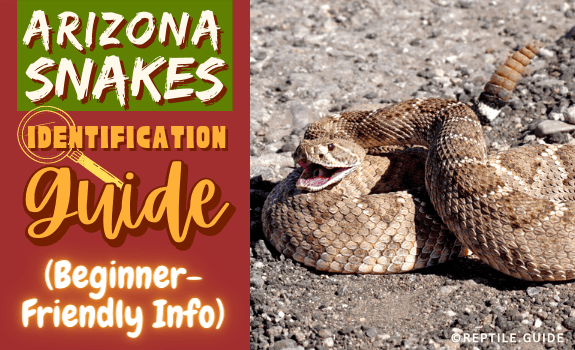The variety of Arizona snakes is vast, ranging from harmless species like the Arizona kingsnake to venomous species like the tiger rattlesnake.
Colors range from red snakes in Arizona to an orange and black snake, or gray and brown snakes.
In this article, we’ll share some Arizona snakes in pictures, and other things you need to know, including:
- What kind of snakes are in Arizona
- How to react if you discover a snake
- Keys to Arizona snakes identification
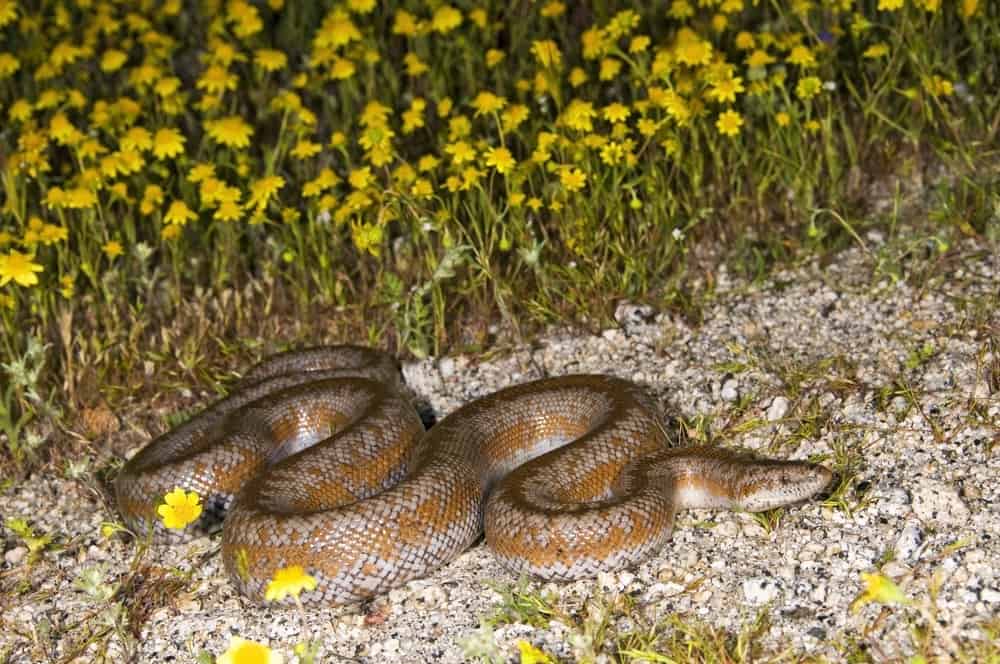
We’ll also share useful resources at the end of the article to help you deal with snakes.
In This Article
Arizona Snakes Identification Basics
When trying to identify a snake found in Arizona, there are a few things to bear in mind. The most essential characteristics include:
- Size
- Habitat and location
- Head and pupil shape
- Coloration and patterning
Snakes have specific distribution ranges, and where you find the snake can lead to successful identification.
If you’re trying to identify snakes in Phoenix, then you won’t start with a list of northern Arizona snakes.
Most species also have habitat preferences. The habitat you find them in can help identify them.
Let’s say that the snake you find is bright red and short. This further narrows down the list. Species like the speckled rattlesnake aren’t red and are quite long.
If you take a closer look at the head and pupil shape, it will give you further clues.
The Arizona coral snake has round pupils and a bullet-shaped head. Arizona rattlesnakes have slit-shaped pupils and broad heads.
Alone, none of the identifying characteristics can give you an answer. However, if you consider all the characteristics, you’ll soon identify the species.
Identifying Venomous Species
Arizona has quite a lot of venomous species compared to some of the other states. From the Arizona ridge-nosed rattlesnake to the coral snake.
Let’s take a closer look at how to spot venomous snakes.
Identifying Rattlesnake Species
Most of the venomous snakes in Arizona are rattlesnakes. Fortunately, these snakes have a set of characteristics that make them easy to spot.
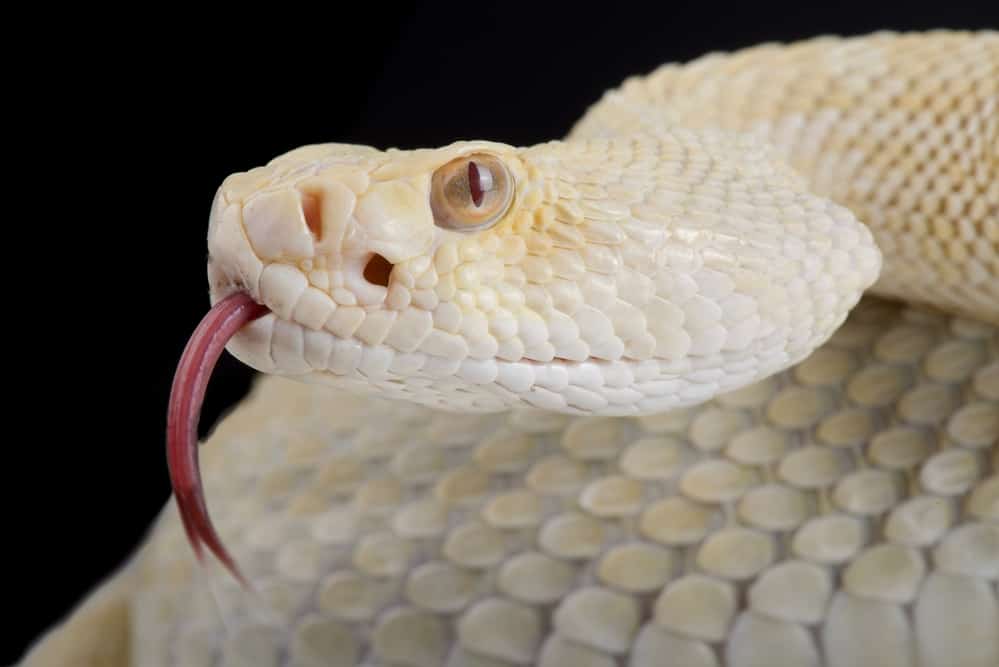
These identifying characteristics set these snakes apart from other snake species:
- Stubby, robust bodies
- Broad, shield-shaped heads
- Elliptical (slit-shaped) pupils
- A large “rattle” at the end of the tail
- Large heat pits located between the eyes and nostrils
No other snake has the signature rattle.
Identifying Coral Snakes
If you’re afraid of coral snakes, it’s easy to confuse species like the ring-necked snake, Western ground snake, or milksnake for it at first glance.
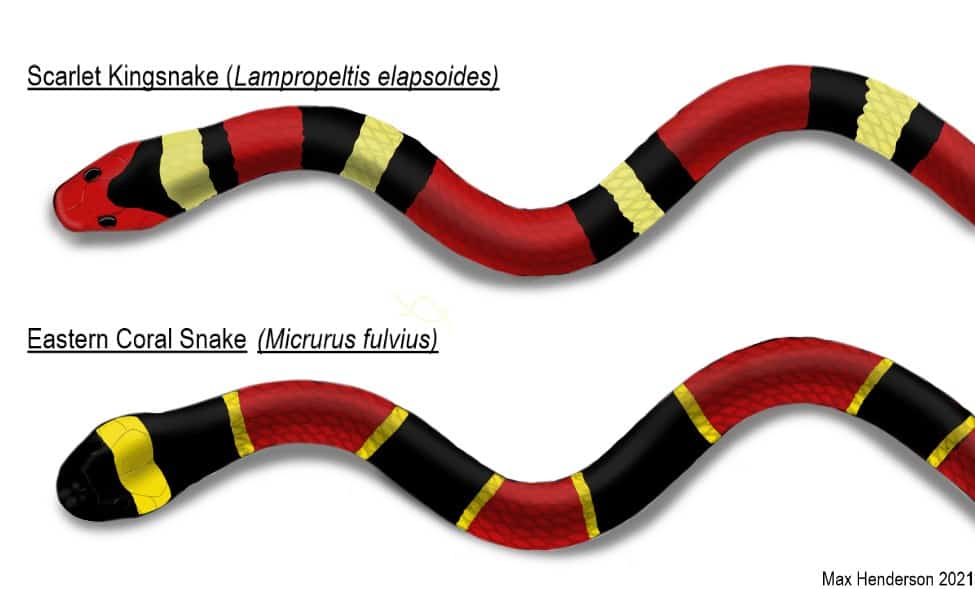
However, if you take a good look, it’s fairly easy to distinguish the coral snake from similar species.
It’s the only snake that has its particular configuration of banding. People that live in areas where coral snakes occur have created a rhyme for it.
Red next to yellow, kill a fellow. Red next to black, friend of Jack. If the red bands lie next to the yellow ones, it’s probably a coral snake.
In most other species, there’s a black band between the red and the yellow bands.
Coral snakes also have complete bands running to their undersides. Most other species’ bands break off on their sides somewhere.
Identifying Vine Snakes and Lyre Snakes
Newcomers to the state may be unfamiliar with these snakes, which have a narrow distribution in the US.
Fortunately, these snakes are easy to identify since they have a pretty unique shape.
Vine snakes have round pupils and distinctive two-tone coloration. Their heads also have a unique shape that resembles the knobbly part of a branch.
Their surface color is dark brown, and the rest of the body (from just below the eye) is white or tan).
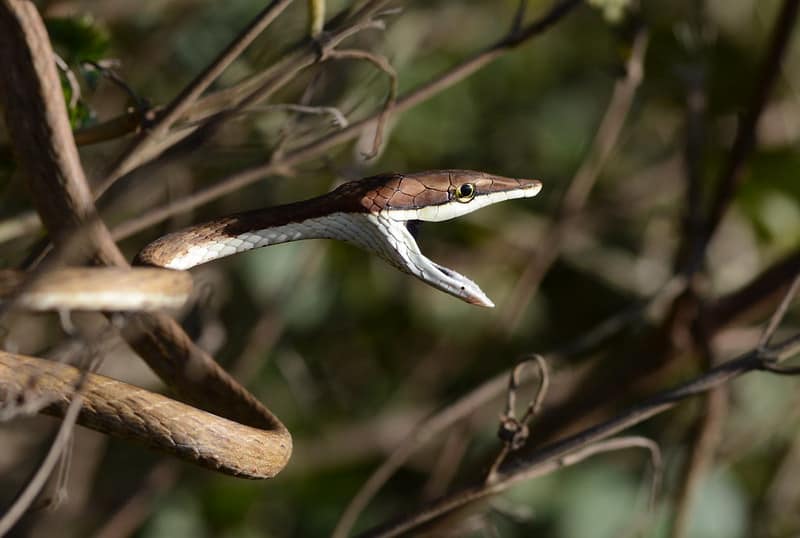
Image credit: Sylvère Corre (via CreativeCommons.org)
Unlike vine snakes, lyre snakes are terrestrial. They have broad heads and narrow necks which make them quite distinctive.
These snakes also sport a v-shaped marking on their heads, which supposedly resembles a lyre. Their pupils are elliptical.
What Kind of Snakes Are in Arizona?
Arizona has approximately 60 species of snake. Of these, around 16 are dangerous to humans, including:
- Rattlesnakes
- Sidewinder – Crotalus cerastes
- Rock Rattlesnake – Crotalus lepidus
- Tiger Rattlesnake – Crotalus tigris
- Prairie Rattlesnake – Crotalus viridis
- Mojave Rattlesnake – Crotalus scutulatus
- Western Rattlesnake – Crotalus oreganus
- Ridge-nosed Rattlesnake – Crotalus willardi
- Twin-spotted Rattlesnake – Crotalus pricei
- Arizona Black Rattlesnake – Crotalus cerberus
- Southwestern Speckled Rattlesnake – Crotalus pyrrhus
- Western Diamond-backed Rattlesnake – Crotalus atrox
- Pygmy Rattlesnakes
- Western Massasauga – Sistrurus tergeminus
- Vine and Lyre Snakes
- Brown Vinesnake – Oxybelis aeneus
- Sonoran Lyre Snake – Trimorphodon lambda
- Coral Snake
- Sonoran Coralsnake – Micruroides euryxanthus
Most of the non-venomous snakes in Arizona fit comfortably into one of a few main groups. These include:
- Shovel-nosed Snakes
- Mohave Shovel-Nosed Snake – Chionactis occipitalis
- Sonoran Shovel-nosed Snake – Chionactis palarostris
- Resplendent Desert Shovel-Nosed Snake – Chionactis annulata
- Hook-nosed Snakes
- Thornscrub Hook-nosed Snake – Gyalopion quadrangulare
- Chihuahuan Hook-nosed Snake – Gyalopion canum
- Nightsnakes
- Desert Nightsnake – Hypsiglena chlorophaea
- Chihuahuan Nightsnake – Hypsiglena jani
- Kingsnakes and Milksnakes
- Desert Kingsnake – Lampropeltis splendida
- Eastern Milksnake – Lampropeltis triangulum
- Western Milksnake – Lampropeltis gentilis
- California King Snake – Lampropeltis californiae
- Arizona Mountain Kingsnake – Lampropeltis pyromelana
- Chihuahuan Mountain Kingsnake – Lampropeltis knoblochi
- Rosy Boas
- Desert Rosy Boa – Lichanura trivirgata
- Coastal Rosy Boa – Lichanura orcutti
- Whipsnakes
- Coachwhip – Masticophis flagellum
- Striped Whipsnake – Masticophis taeniatus
- Sonoran Whipsnake – Masticophis bilineatus
- Leaf-Nosed Snakes
- Saddled Leaf-nosed Snake – Phyllorhynchus browni
- Western Leaf-nosed Snake – Phyllorhynchus decurtatus
- Threadsnakes
- Western Threadsnake – Rena humilis
- New Mexico Blind Snake – Rena dissecta
- Patchnose Snakes
- Big Bend Patchnose Snake – Salvadora deserticola
- Eastern Patch-nosed Snake – Salvadora grahamiae
- Western Patch-nosed Snake – Salvadora hexalepis
- Black-headed Snakes
- Yaqui Black-headed Snake – Tantilla yaquia
- Plains Black-headed Snake – Tantilla nigriceps
- Southwestern Blackhead Snake – Tantilla hobartsmithi
- Chihuahuan Black-headed Snake – Tantilla wilcoxi
- Garter Snakes
- Mexican Garter Snake – Thamnophis eques
- Checkered Garter Snake – Thamnophis marcianus
- Narrowhead Garter Snake – Thamnophis rufipunctatus
- Black-necked Garter Snake – Thamnophis cyrtopsis
- Western Terrestrial Garter Snake – Thamnophis elegans
- Gopher Snakes
- Gopher Snake – Pituophis catenifer
- Gopher Snake – Pituophis melanoleucus
The other snakes that lack venom are singular representatives of their genera. These species include:
- Sand Snake – Chilomeniscus stramineus
- Glossy Snake – Arizona elegans
- Western Ground Snake – Sonora semiannulata
- Green Rat Snake – Senticolis triaspis
- Long-nosed Snake – Rhinocheilus lecontei
- Ring-necked Snake – Diadophis punctatus
- Banded Watersnake – Nerodia fasciata
- Brahminy Blindsnake – Indotyphlops braminus
- Mexican Hognose Snake – Heterodon kennerlyi
Most Common Snakes in Arizona
According to iNaturalist, the following ten species are the most commonly sighted snakes in Arizona:
- Western Diamond-backed Rattlesnake – Crotalus atrox
- Gopher Snake – Pituophis catenifer
- Western Black-Tailed Rattlesnake – Crotalus molossus
- Mojave Rattlesnake – Crotalus scutulatus
- Long-nosed Snake – Rhinocheilus lecontei
- Coachwhip – Masticophis flagellum
- California King Snake – Lampropeltis californiae
- Sidewinder – Crotalus cerastes
- Black-necked Gartersnake – Thamnophis cyrtopsis
- Western Terrestrial Garter Snake – Thamnophis elegans
Venomous Snakes in Arizona
Arizona has more venomous snakes than most other states. Let’s take a look.
Lyre Snake
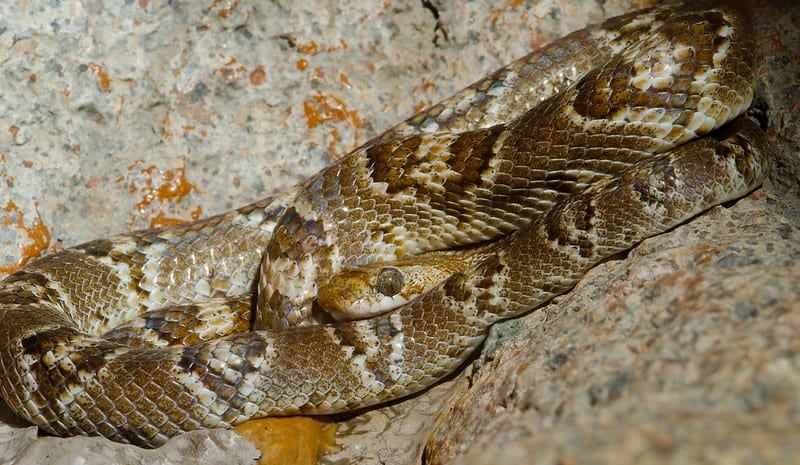
Image credit: guppiecat (via CreativeCommons.org)
|
Scientific Name: |
Trimorphodon lambda |
|---|---|
|
Range: |
Southern, West Central, and Northwest Arizona |
|
Adult Size: |
18 to 47 inches |
|
Description: |
Slit-shaped pupils A distinctive v-shaped marking on the head Brownish snakes with darker brown markings that are almost diamond-shaped |
|
Habitat: |
Deserts and scrublands |
|
Venomous/Non-Venomous: |
Venomous |
Vine Snake
The vine snake looks almost exactly like a branch, which is where it gets its name.
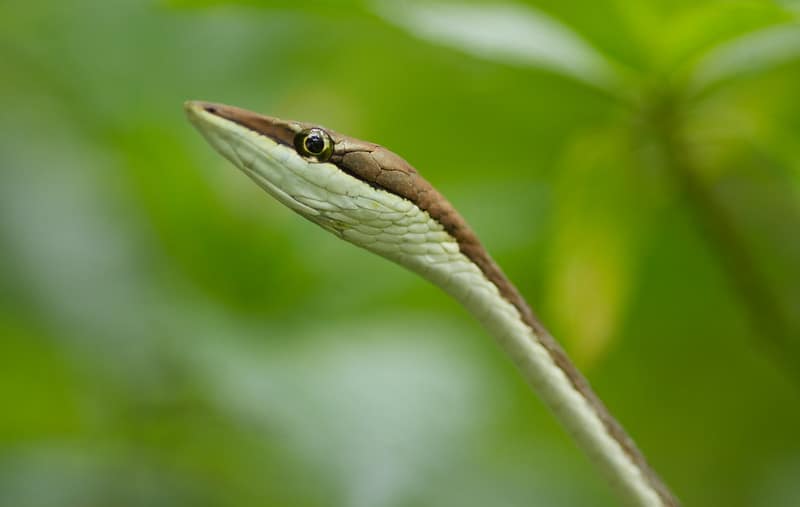
Image credit: brian.gratwicke (via CreativeCommons.org)
|
Scientific Name: |
Oxybelis aeneus |
|---|---|
|
Range: |
Mostly in Western Arizona |
|
Adult Size: |
Up to six feet |
|
Description: |
Brown upperside, and a light underside Round pupils and a pointy elongated head It has a very long tail, and the snake is slender |
|
Habitat: |
Anywhere with sufficient vegetation |
|
Venomous/Non-Venomous: |
Venomous |
Coral Snake
The coral snake is one of the prettiest deadly snakes on the planet. Its coloration is truly striking.
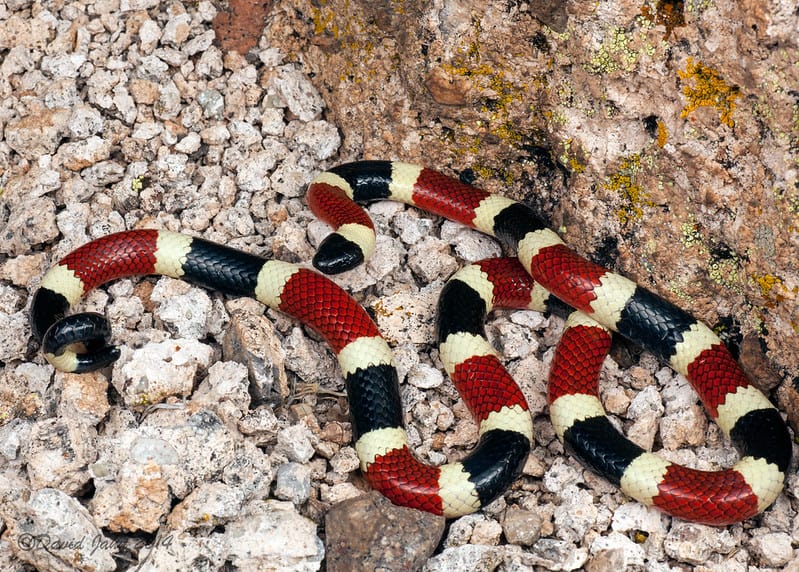
Image credit: David A Jahn (via CreativeCommons.org)
|
Scientific Name: |
Micruroides euryxanthus |
|---|---|
|
Range: |
Southeast to central Arizona |
|
Adult Size: |
13 to 21 inches |
|
Description: |
Round pupils, and a rounded head A black snake with solid red and white bands that continue to the snake’s underside |
|
Habitat: |
Generalists, prefer dry areas with sandy soils |
|
Venomous/Non-Venomous: |
Venomous |
Arizona Rattlesnakes
Arizona has more rattlesnake species than several of the other states combined.
We’ll take a look at this group as a whole, then discuss a few significant species.
|
Scientific Name: |
Genera Crotalus and Sistrurus Species: Sidewinder – Crotalus cerastes Rock Rattlesnake – Crotalus lepidus Tiger Rattlesnake – Crotalus tigris Hopi Rattlesnake – Crotalus viridis Mojave Rattlesnake – Crotalus scutulatus Western Rattlesnake – Crotalus oreganus Black-Tailed Rattlesnake – Crotalus molossus Ridge-nosed Rattlesnake – Crotalus willardi Twin-spotted Rattlesnake – Crotalus pricei Arizona Black Rattlesnake – Crotalus cerberus Southwestern Speckled Rattlesnake – Crotalus pyrrhus Western Diamond-backed Rattlesnake – Crotalus atrox Western Massasauga – Sistrurus tergeminus |
|---|---|
|
Range: |
Across Arizona |
|
Adult Size: |
22 inches (Western Massasauga) to 66 inches (Western diamondback rattlesnake) |
|
Description: |
The Arizona Black Rattlesnake is solid black Broad, shield-shaped heads and elliptical pupils Stout-bodied, robust snakes in shades of grey and brown Final scales on the tails adapted to form a stiff “rattle” |
|
Habitat: |
Ranges from desert to prairie and grassland |
|
Venomous/Non-Venomous: |
Venomous |
Western Diamondback Rattlesnake
The Western diamondback rattlesnake, Crotalus atrox, is the largest species of rattlesnake.
It’s also responsible for most of the rattlesnake bites in the US every year.
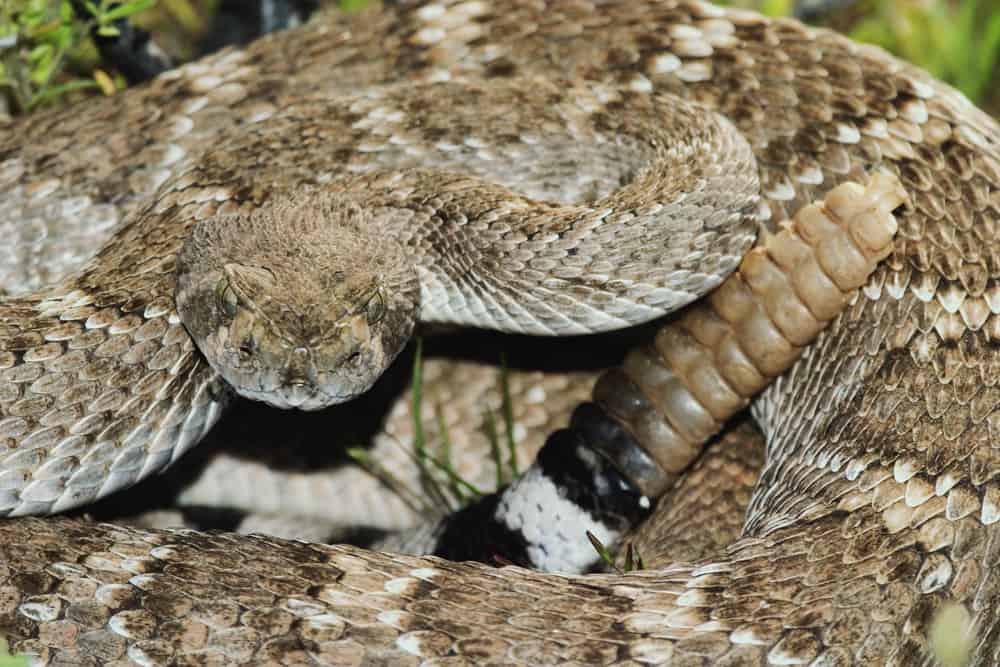
The Western diamondback rattlesnake, Crotalus atrox, is common in Nevada since it prefers habitats like deserts and scrublands.
Tiger Rattlesnake
The tiger rattlesnake, Crotalus tigris, is a medium to large snake with a vibrant striped design.
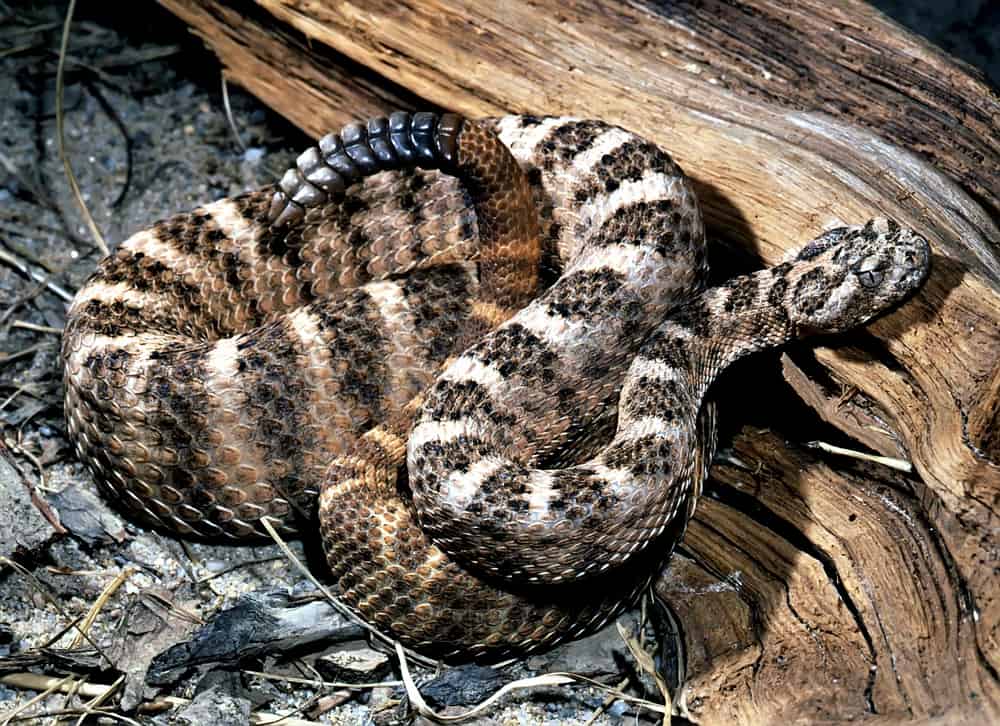
These snakes commonly reside in rocky canyons and foothills in a desert environment.
Mojave Rattlesnake
The Mojave rattlesnake is a long species, reaching lengths of 54 inches.
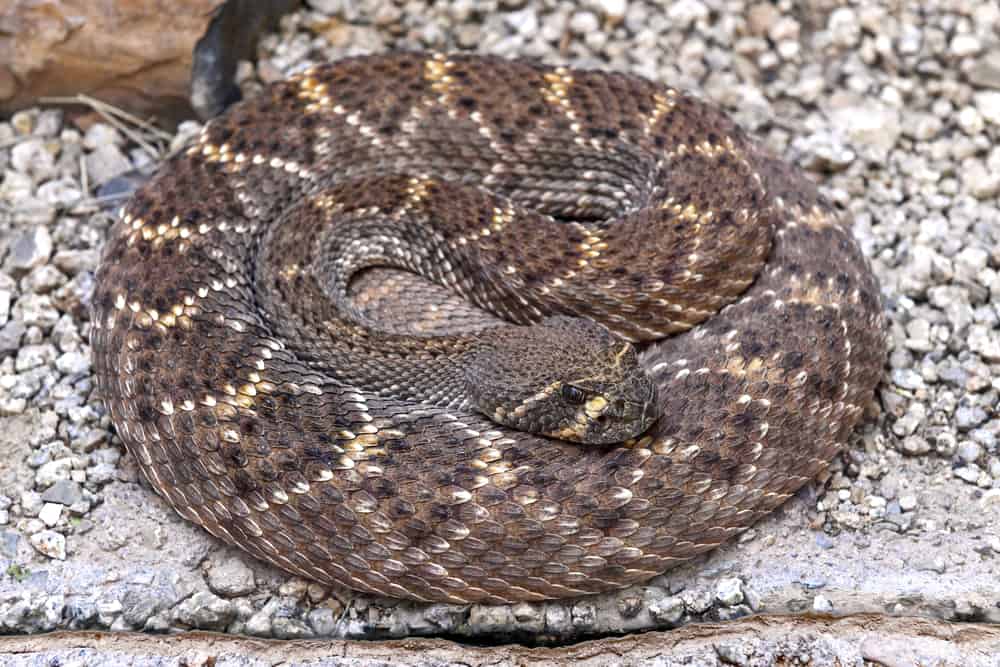
Many experts consider the Mojave rattlesnake to be the most toxic snake species in the US.
Speckled Rattlesnake
Unlike the tiger rattlesnake and the Western diamondback rattlesnake, this species is light.
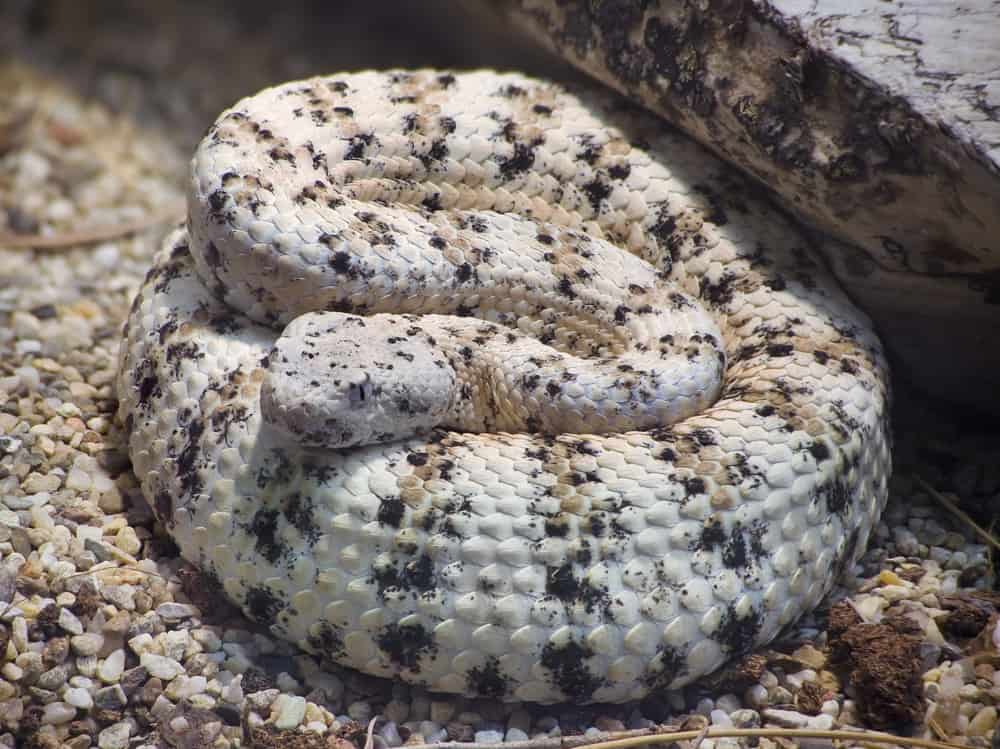
The speckled rattlesnake, Crotalus pyrrhus, is light gray, and may even be white. Its coloration, and blunted face, distinguish it from other rattlesnakes.
Sidewinder Rattlesnake
The sidewinder, Crotalus cerastes, is a medium-large snake, and it’s the only rattlesnake with horns.
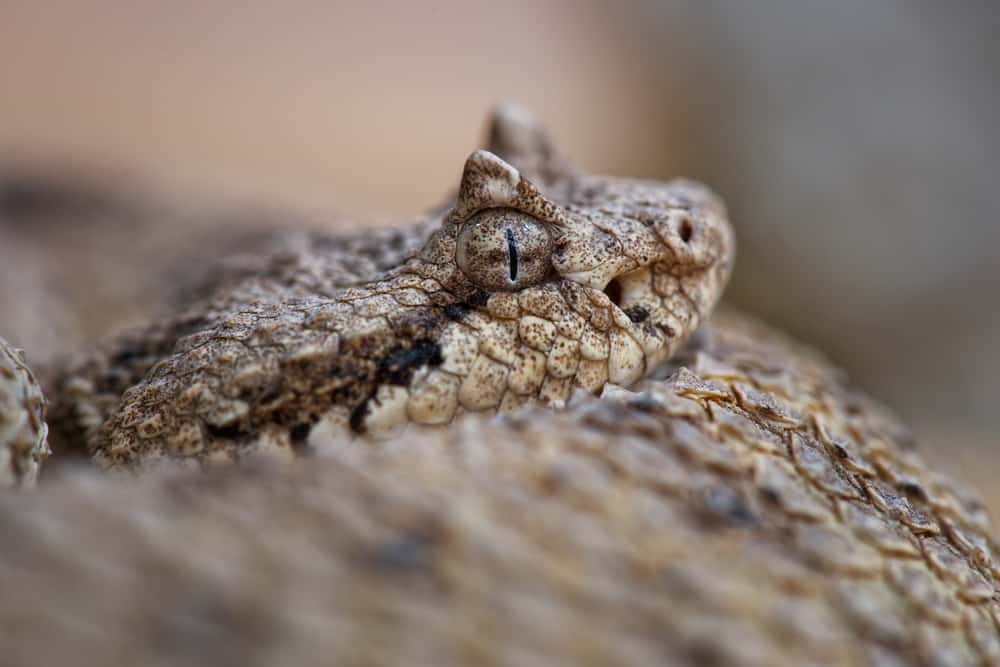
This snake gets its name from the way it moves, by throwing its body from side to side.
Western Massasauga
The Massasauga is the only species of the genus Sistrurus, found in Arizona.
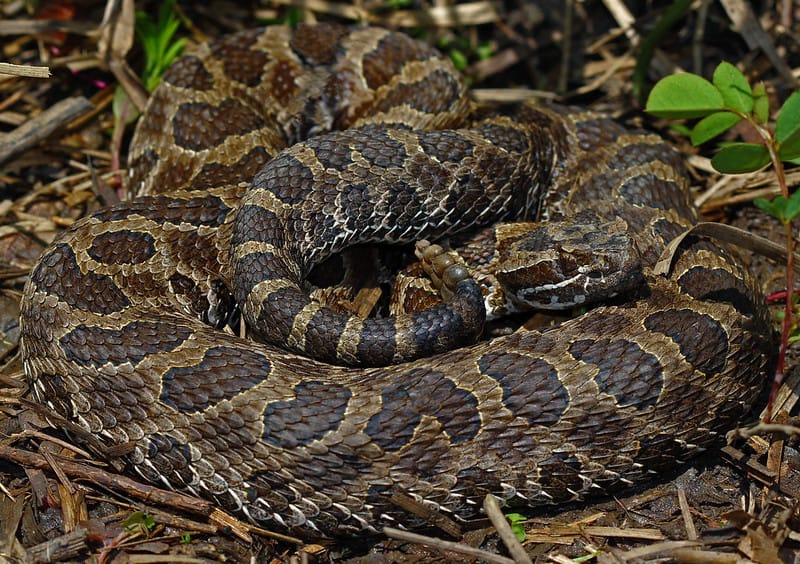
Image credit: 2ndPeter (via CreativeCommons.org)
In many US states a closely related species, the Pygmy Rattlesnake, is well-known.
Snakes in this genus are much smaller than those in the genus Crotalus, and this species reaches lengths of up to 36 inches.
Non-Venomous Snakes in Arizona
Most of the snakes in Arizona are non-venomous. Let’s take a look at one or two of them.
Saddled Leaf-Nosed Snake
The saddled leaf-nosed snake, Phyllorhynchus browni, is a relatively small species. It prefers areas with sandy soils.
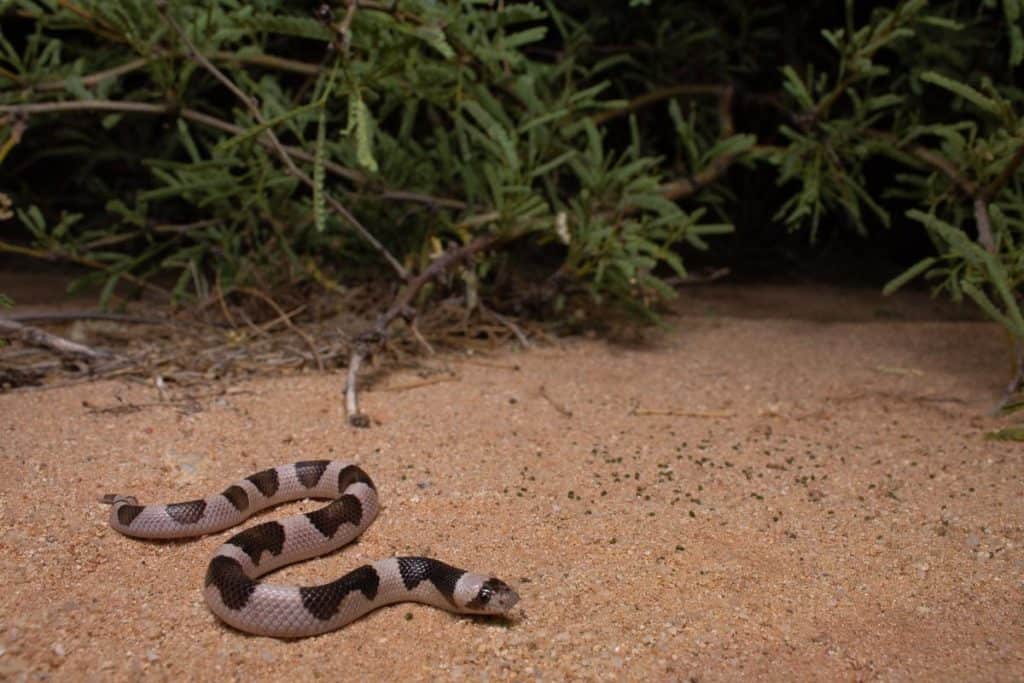
Image credit: u/touchmyrattlesnakes (via Reddit.com)
|
Scientific Name: |
Saddled Leaf-nosed Snake Phyllorhynchus browni Western Leaf-nosed Snake Phyllorhynchus decurtatus |
|---|---|
|
Range: |
Southwest Arizona |
|
Adult Size: |
Six to 20 inches |
|
Description: |
The tail tapers to a point A striking snake with a blunt, rounded head A light background with dark black blotches, including a mask-like marking over the eyes |
|
Habitat: |
Desert Scrublands |
|
Venomous/Non-Venomous: |
Non-venomous |
Long-Nosed Snake
The long-nosed snake is a distinctive-looking species that you’re unlikely to confuse with another snake.
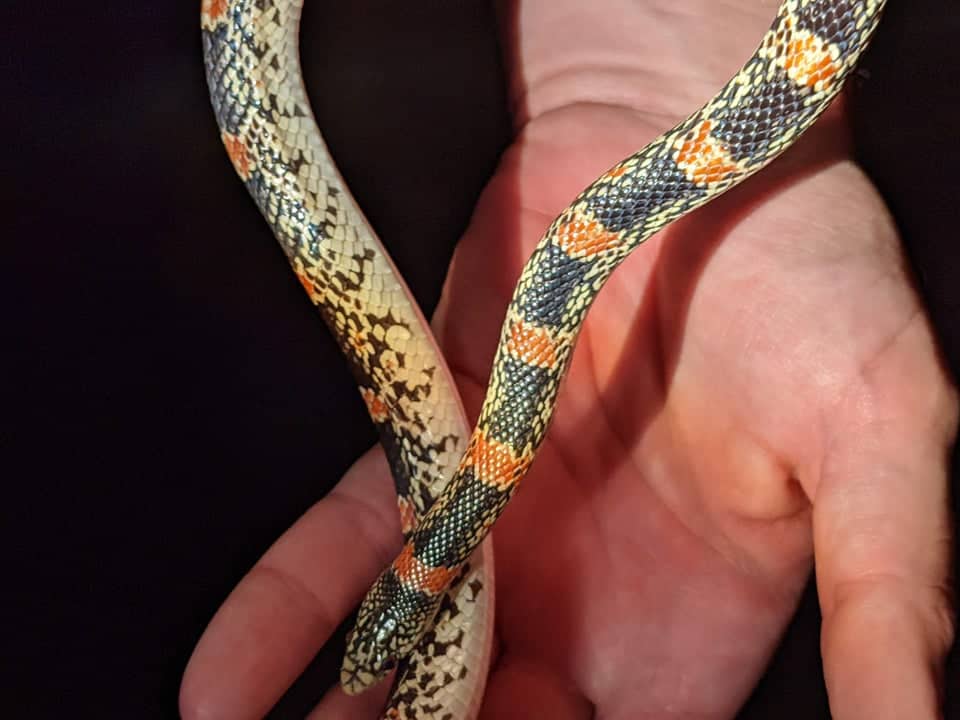
Image credit: u/[deleted] (via Reddit.com)
|
Scientific Name: |
Rhinocheilus lecontei |
|---|---|
|
Range: |
Southern and Western Arizona, stretching into the Northwest |
|
Adult Size: |
Averages around 30 inches |
|
Description: |
A medium-length snake with a sharp snout Yellowish base color with orange and black bands which break into speckles on the side of the snake |
|
Habitat: |
Deserts, grasslands, and prairies |
|
Venomous/Non-Venomous: |
Non-venomous |
Gopher Snakes
The gopher snakes are harmless terrestrial hunters.
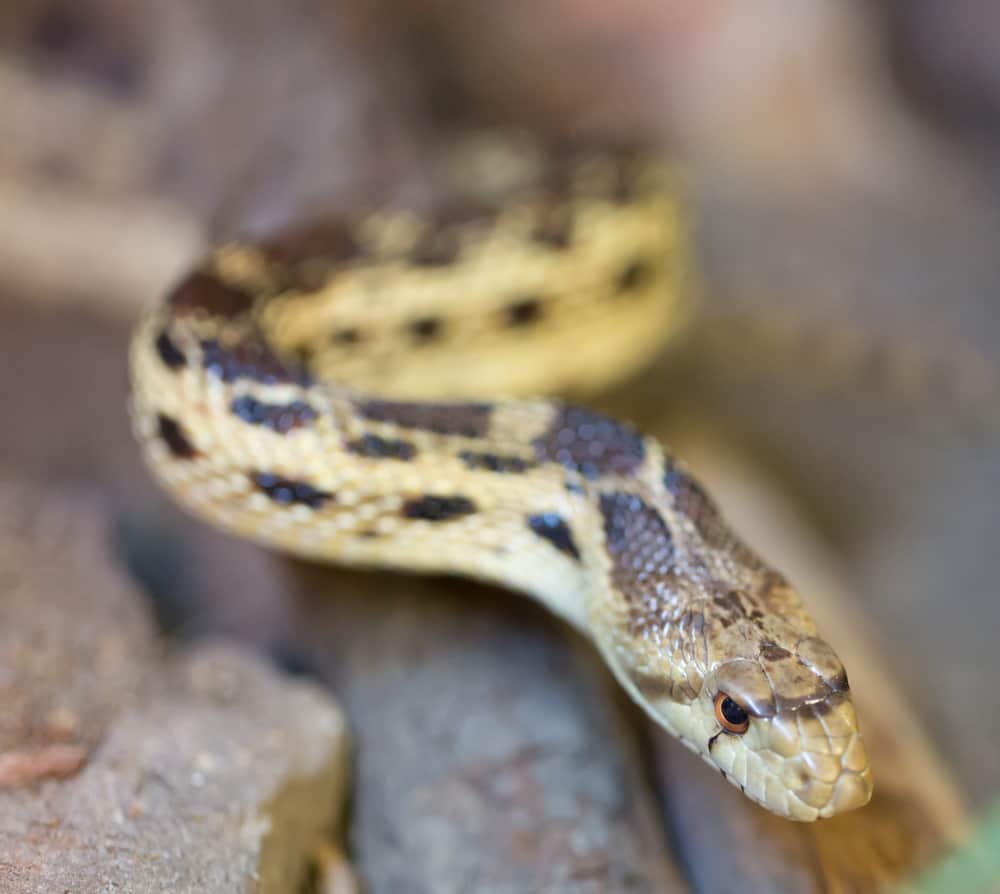
|
Scientific Name: |
Genus: Pituophis Species: Pituophis catenifer Pituophis melanoleucus |
|---|---|
|
Range: |
Throughout Arizona |
|
Adult Size: |
Up to eight feet |
|
Description: |
Robust snakes Light brown with dark grey-brown blotches or stripes |
|
Habitat: |
Flat, dry habitats without dense cover |
|
Venomous/Non-Venomous: |
Non-Venomous |
Some scientists break down Pituophis catenifer into the Sonoran gopher snake, P. c. affinis, and the Great Basin gopher snake, P. c. deserticola.
The Great Basin gopher snake lives in the Great Basin, while the other species exists in the Sonoran desert.
Iconic Arizona Snake Species
We’ve made a list of some of our favorite snake species that live in Arizona’s native desert habitat. These guys belong on your bucket list.
Thornscrub Hook-Nosed Snake
The thornscrub hook-nosed snake, Gyalopion quadrangulare, is one of two hook-nosed snakes in the region.
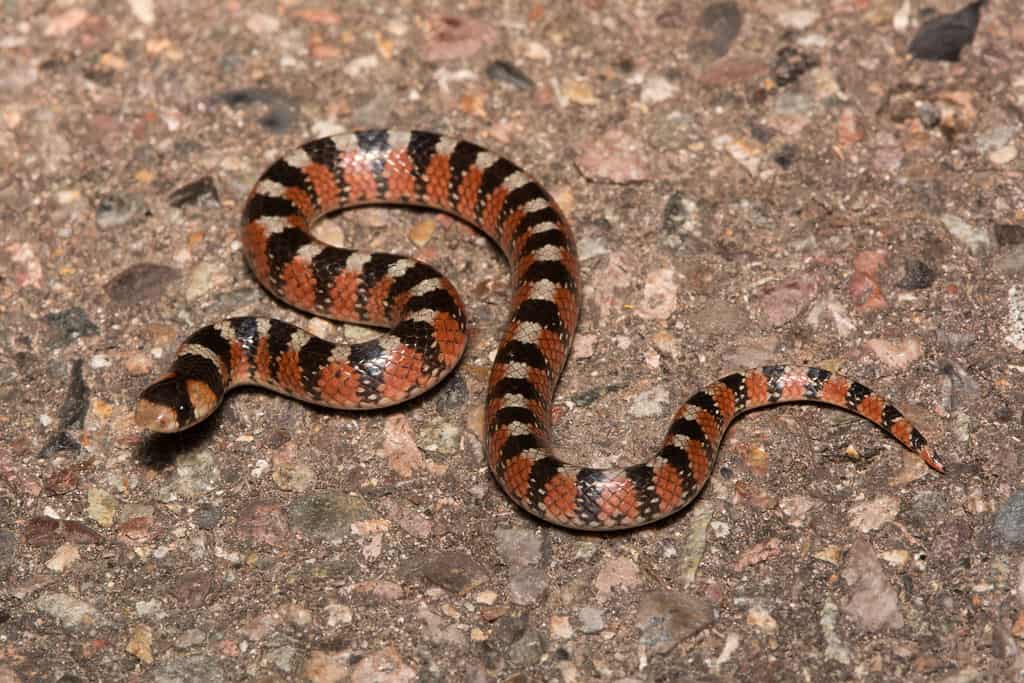
Image credit: amdubois01 (via CreativeCommons.org)
|
Scientific Name: |
Gyalopion quadrangulare |
|---|---|
|
Range: |
Southeast Arizona |
|
Adult Size: |
Up to ten inches |
|
Description: |
Short, thick-bodied snake with orange and brown banding. A slightly broadened, rounded head with round pupils. A white vertebral stripe spans from the neck to the tail. |
|
Habitat: |
Desert scrublands |
|
Venomous/Non-Venomous: |
Non-venomous |
Glossy Snake
The glossy snake, Arizona elegans, is a beautiful species with a blunted head.
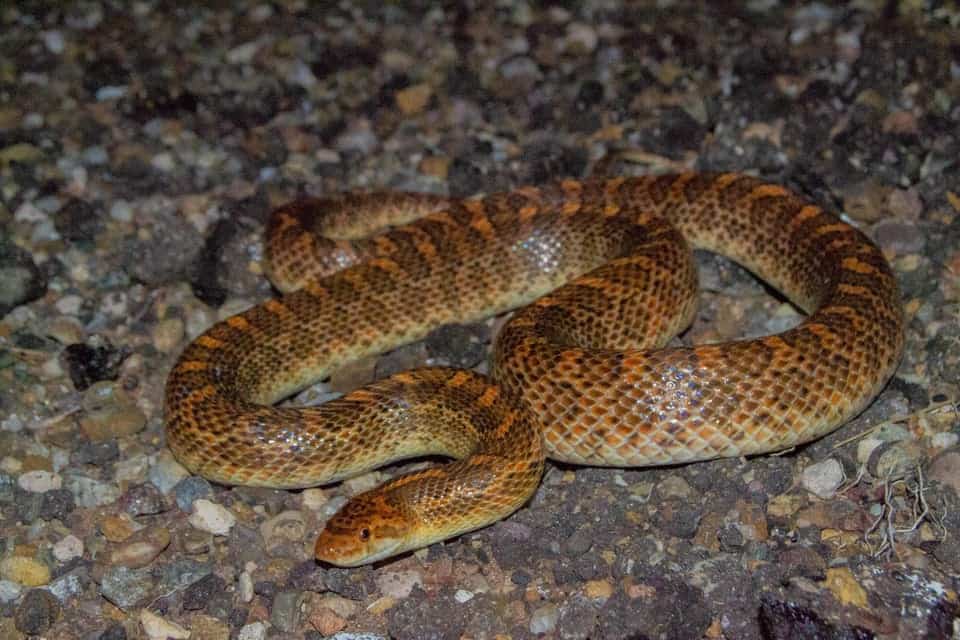
|
Scientific Name: |
Arizona elegans |
|---|---|
|
Range: |
Most of Arizona, excluding a band that runs from the Northeast, through central Arizona, and into the Southeast |
|
Adult Size: |
26 – 70 inches |
|
Description: |
Round pupils Alternating brown and tan blotches A long, tapering tail and a blunt snout |
|
Habitat: |
Deserts and arid grasslands |
|
Venomous/Non-Venomous: |
Non-venomous |
Resplendent Desert Shovel-Nosed Snake
The resplendent desert shovel-nosed snake is a beautifully colored species. It’s one of three species in the genus that occur in Arizona.
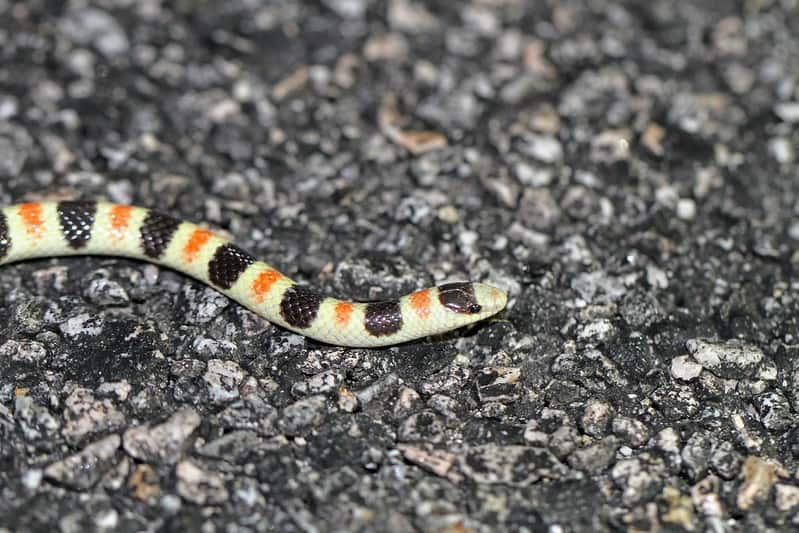
Image credit: Greg Schechter (via CreativeCommons.org)
|
Scientific Name: |
Chionactis annulata |
|---|---|
|
Range: |
Southwest and South-central Arizona |
|
Adult Size: |
Averages 11 to 17 inches |
|
Description: |
A colorful species with a pale background and red and black bands The pupils are round, and the snake has a rounded head and tail |
|
Habitat: |
Dry, sandy deserts |
|
Venomous/Non-Venomous: |
Non-venomous |
Western Patch-Nosed Snake
The Western patch-nosed snake, Salvadora hexalepis, is one of three species in the genus that occur in Arizona.
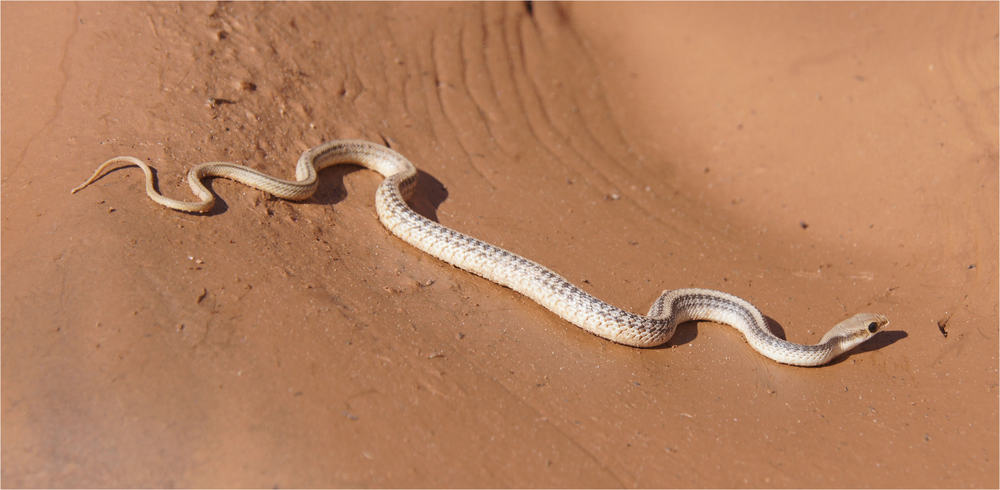
|
Scientific Name: |
Salvadora hexalepis |
|---|---|
|
Range: |
Throughout Arizona, excluding the northeast quadrant |
|
Adult Size: |
Averages 20 to 46 inches |
|
Description: |
Elongated heads with round pupils A long, narrow snake with two long black vertical bands alongside a wide central band |
|
Habitat: |
Sandy and rocky habitats |
|
Venomous/Non-Venomous: |
Non-venomous |
Coexisting with Arizona Snakes
Snakes are a highly beneficial group of animals in most cases.
Species like the Western ground snake play an important role in balancing the ecosystem. They do this by:
- Acting as a food source for predators like badgers and eagles.
- Managing the populations of rodents that transport disease-carrying ticks.
- Preventing other small animal populations from growing to sizes that the environment can’t support.
If you know how to treat them, snakes are easy to get along with. Let’s take a closer look.
Snake Safety 101
- Always treat snakes with respect
- Never prod, tease, or bother a snake in any way
- Always wear sturdy shoes when entering potential snake habitats
- If a snake is where it doesn’t belong, contact a professional to remove it
Treading Carefully in Snake Habitat
Most of the time, people get bitten because they accidentally step on a snake.
It’s vital to tread carefully in snake habitat.
When you enter a likely snake habitat, always:
- Stay observant and tread lightly
- Ensure that you’re wearing sturdy shoes
- Stick to well-used footpaths and hiking trails
- Keep your pets on leashes, and your children near you
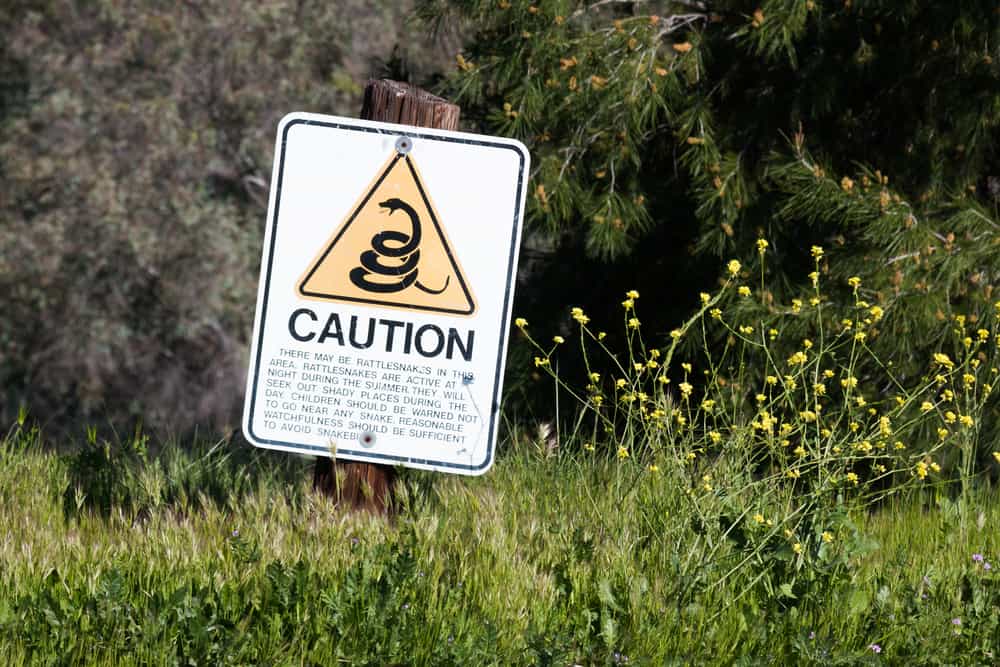
If You Encounter a Snake
Typically, when you encounter a snake, you won’t need to do anything. You can observe and photograph the snake from a safe distance. You can also simply back away and leave.
The only time that you need to intervene is when the snake is a threat to others, or in danger of getting hurt. In those cases, it’s best to contact a wildlife trapper.
Useful Resources
We’ve gathered our favorite resources for learning about snakes and dealing with them.
Emergency Poisoning Advice
Snake Relocation Services
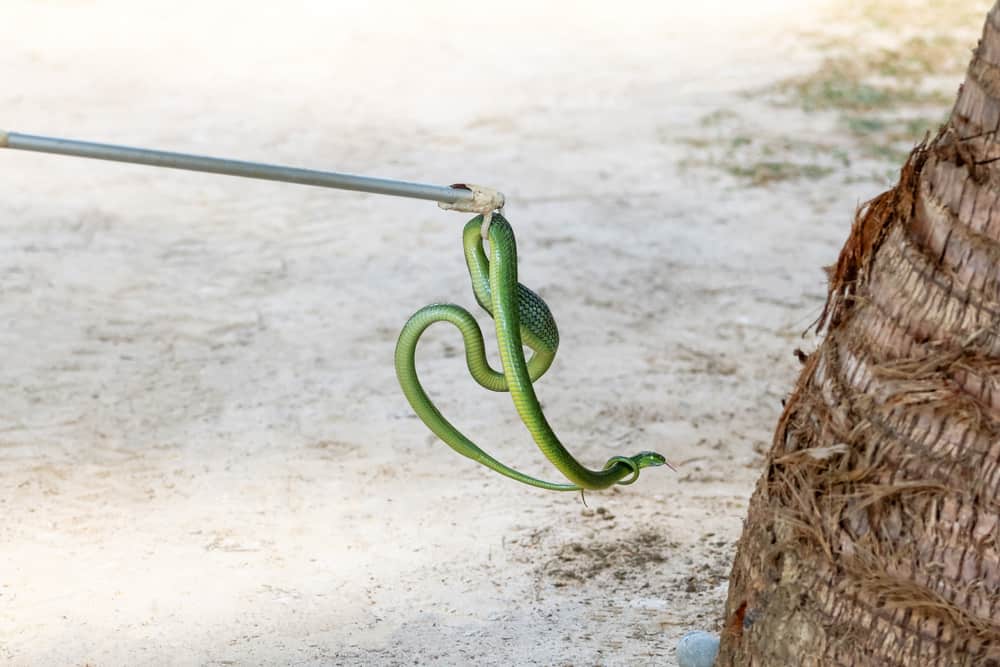
Educational Resources
- iNaturalist – a website for identifying and learning about wildlife.
- The Arizona Game and Fish Commission’s brochure about living with venomous snakes.
- We hope you’ve enjoyed this article about Arizona snakes. Whether you’re looking for a black and white snake in Arizona, or something else entirely, this guide will get you started.
Related Articles to Arizona Snakes Identification Guide
If you’re interested in other identification guides, have a look at:
- Florida Snakes Identification Guide
- Texas Snakes Identification Guide
- California Lizards Identification Guide
You can also check out our other articles on snakes – we have vital guides that you can learn from!
